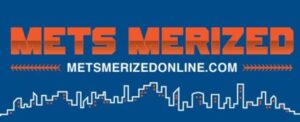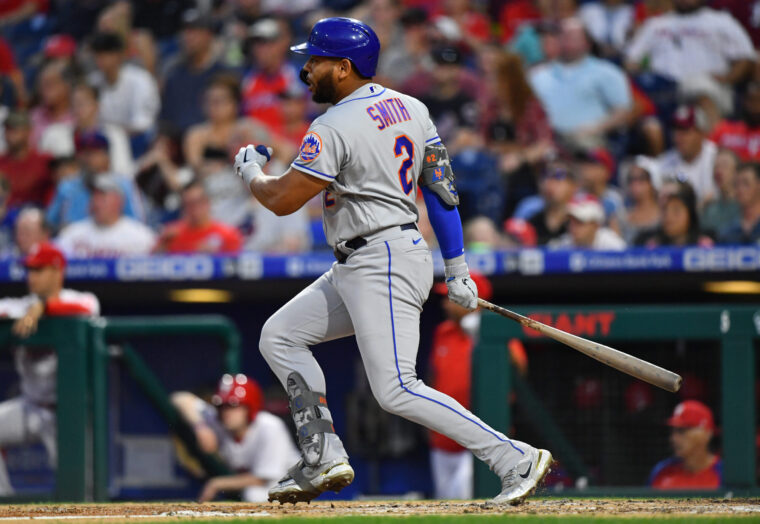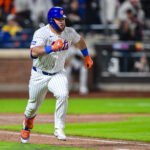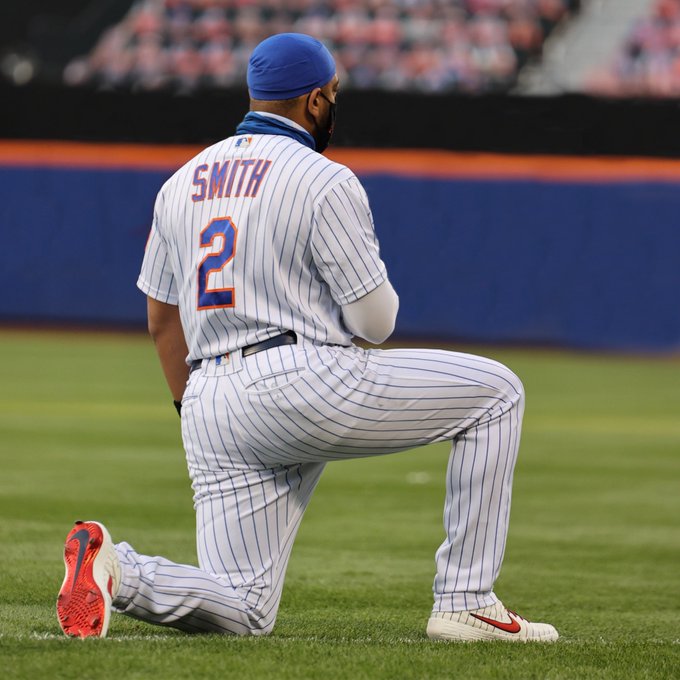
Photo from the Mets
For several players across the major leagues, the 2021 season should serve as one to forget, and with just three weeks remaining until the regular season draws to a close, no one will likely be happier to turn the page to 2022 than slugger Dominic Smith.
After being limited to a part-time role through his first three seasons with the New York Mets, Smith took full advantage of the universal designated hitter last season, allowing him to assume a much larger role during the 60-game schedule. With the 26-year-old spending the majority of his time at first base and the DH spot, he was able to focus heavily on the offensive aspect of his game, which took a massive step forward.
Despite the shortened schedule, the left-hander still surpassed his previous career-high in plate appearances, compiling 199 in that regard, and also proved to be one of the club’s top run producers. In turn, his offensive outburst allowed him to enjoy one of the most efficient statistical performances of his entire career.
Catching almost everyone by surprise, Smith improved his ability to hit for contact and power, as he produced 21 doubles, 10 home runs, 42 RBIs, a .299 ISO, a .368 BABIP, a .412 wOBA, a 164 wRC+ score, a 1.8 fWAR rating (career-best) and a slashing line of .316/.377/.616/.993 over 50 games in 2020.
Following this remarkable showing, the Mets were counting on the former first-round pick to build off these stellar results and maintain his role as a reliable middle-of-the-order weapon. Unfortunately, that hasn’t been the case this season as he’s failed to play up to his fairly high expectations, causing him to endure an extremely disappointing offensive campaign.
Experiencing a major regression from last season’s breakout performance, the versatile slugger has struggled mightily in multiple different areas, resulting in just 16 doubles, 11 home runs, 55 RBIs, a .116 ISO (career-worst), a .295 BABIP, a .324 wOBA, an 85 wRC+ score, a -0.6 fWAR rating and a slashing line of .243/.305/.359/.664 through 469 plate appearances.
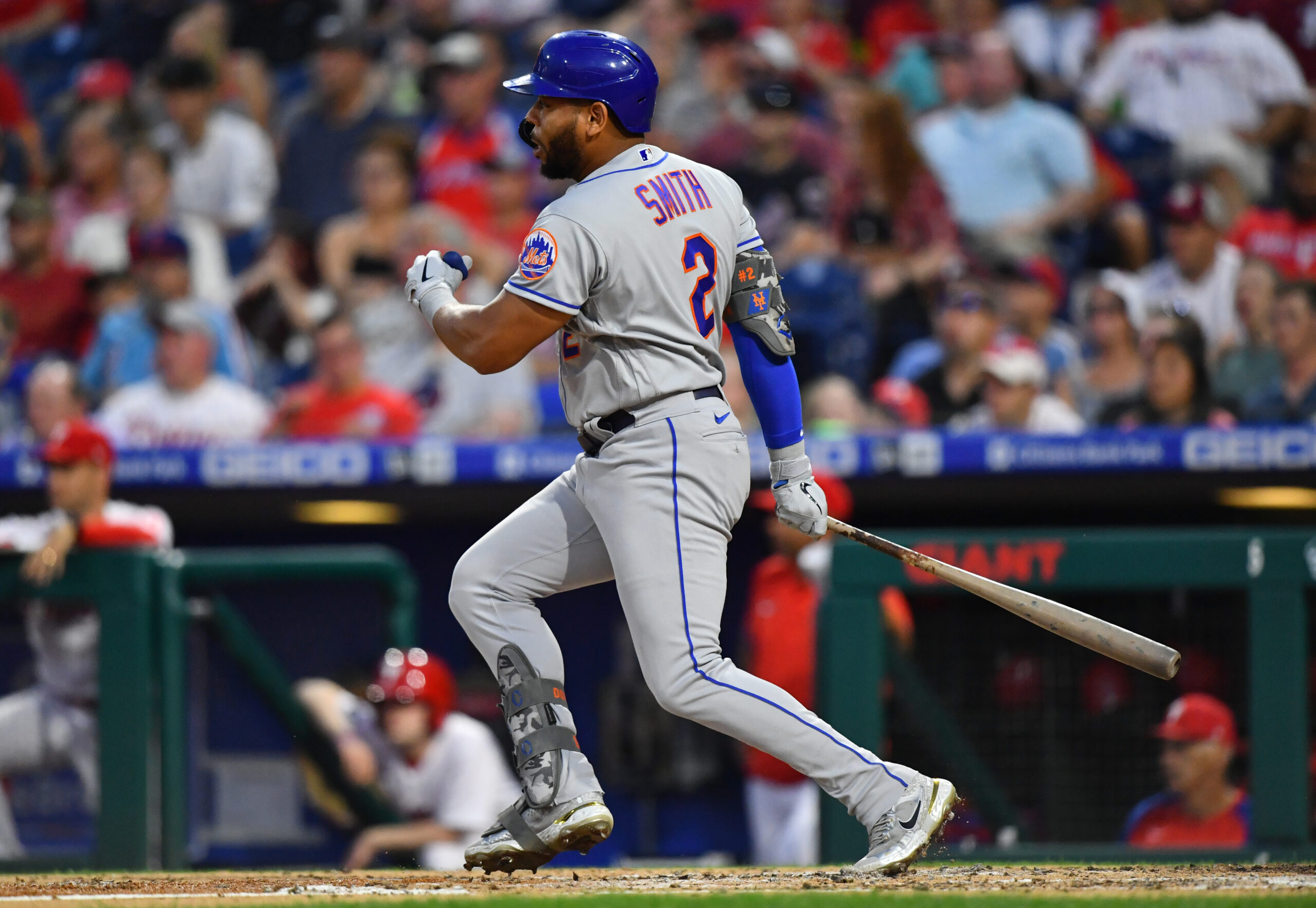
Credit: Kyle Ross-USA TODAY Sports
Digging deeper into Smith’s offensive woes, he hasn’t generated nearly as much hard contact in 2021, as he’s recorded a 39.6% hard-hit rate, a 6.5% barrel rate and an 88.9 mph average exit velocity over 323 batted-ball events. In comparison, the California native created career-highs involving his hard-hit rate (46.7%), barrel rate (13.3%) and average exit velocity (89.8 mph) through 135 batted-ball events in 2020.
Paired with his disappointing performance at the plate, the former top prospect has also failed to perform effectively with his glove in the outfield, particularly during the second half of the season.
Since Major League Baseball and the MLB Players Association couldn’t agree to a deal prior to Opening Day, the universal DH didn’t return for a second straight campaign, which has forced Smith to primarily be positioned in left field this season. While expectations were set fairly low out of the gate, his hard work throughout spring training ultimately helped him perform respectably early on.
Finding a way to thrive defensively through the first two months of the schedule, the Junipero Serra HS standout made a surprisingly positive impact in the outfield and reached his peak in May, where he finished tied for the highest OAA (+1) among all qualified Mets outfielders, according to BaseballSavant.com.
Though his defensive showing through April and May was very encouraging, sadly, Smith couldn’t sustain his early success and has since fallen down a miserable path, causing him to become a significant defensive liability. As a result, he’s produced a -7 OAA since the start of June – not something most experts were expecting following his promising start.
Based on this defensive regression, the Mets’ left fielder’s overall metrics have understandably taken a major hit and have fallen far below league average. In turn, the once-reliable offensive contributor has transformed into one of the worst defending outfielders in the majors, positioning him near the bottom of the leaderboard in several different categories.
Proving left field isn’t a viable option long-term, Smith has produced the sixth-worst UZR/150 (-6.7), is tied for the seventh-fewest DRS (-4), tied for the eighth-worst UZR (-3.7) and has created the 10th-worst RngR (-3.2) among all qualified outfielders, according to FanGraphs.com.
Additionally, he’s also currently tied for the worst OAA (-9) among those same qualifications.
What’s been the main cause for this lack of success? Well, Smith has never been one of the quickest runners on New York’s roster, and despite his best efforts, that’s exactly what’s gotten exposed throughout this season.
Unable to rely on speed, the offensive-first outfielder has endured plenty of issues when he’s needed to cover plenty of ground, especially while ranging back towards the outfield wall. Adding to his defensive woes, he’s also struggled at taking direct routes to fly balls, making his job as an outfielder even more challenging.
Putting these traits into perspective, Smith is currently tied for the eighth-worst burst (-0.4 feet), tied for the 10th-worst jump (-0.9 feet) and is tied for the 13th-worst route (-0.3 feet) among all qualified outfielders in the majors this season – all three of these components are calculated against the major league average.
With Smith performing as a negative offensive and defensive player, manager Luis Rojas and his staff had no other choice but to start limiting the left-hander’s playing time, which has primarily seen him serve as a pinch hitter in September. Considering teammate Jeff McNeil has been forced into the outfield with Javier Baez occupying duties at second base, playing time in left field could be hard to come by the rest of the way.
Barring some sort of last-minute revival, the “Sloth Bear” will likely remain in his bench role through the rest of the season, and assuming the universal DH returns in 2022, he probably won’t spend much time, if any at all, in the outfield moving forward. In addition, he’ll also likely split time at first base with Pete Alonso, who’ll likely remain the everyday first baseman next season.
Given the offensive and defensive success he enjoyed in 2020, reducing Smith’s opportunities in left field could provide him with a quality chance to recapture at least some of the momentum he created during the shortened season.
For the Mets’ sake, taking this route might be the only hope they have at regaining their power-slugging threat from the left side of the plate next season.
